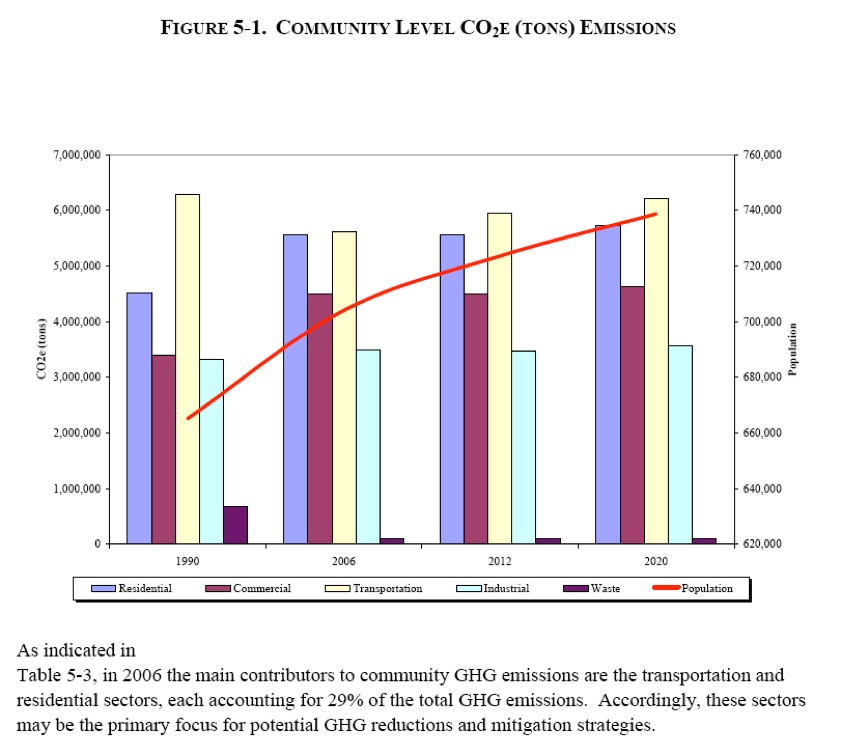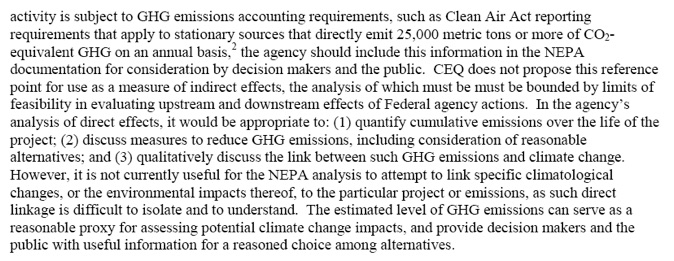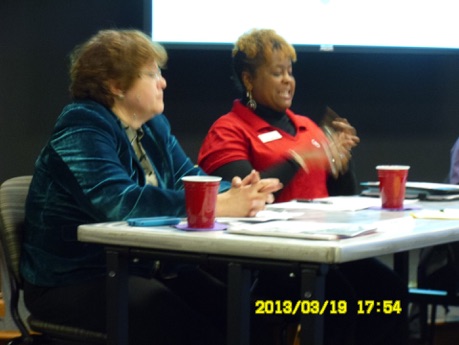Welcome to BadwaterJournal.com©
With climate change effects costing nation billions in storm damage,
FHWA and KYTC declined to estimate green house gas emissions of
Bridges Project alternatives

But the last major project to come out of KIPDA was part of the old “transportation projects as pork barrel spending.”
The LSIORBP, the Bridges Project planners KYTC and INDOT in 2010 to 2012 simply refused to analyze the differences in emissions between a light rail plan, and increased automobile traffic from highway-only alternatives.
In February 2010, the Council on Environmental Quality released new Guidance for integrating greenhouse gas emissions analysis as part of the “hard look” at environmental impacts of major federally funded transportation projects.
KYTC and INDOT were already heavily committed to building two bridges and did not want to examine the difference in greenhouse gas emission that would be clear between a light rail alternative and more cars, cars, cars. CART objected to the failure to analyze greenhouse gas emissions in the EIS.
“Defendants had prior knowledge of, but deliberately withheld from consideration in the NEPA process or any publication in the SFEIS, the green house gas emissions findings from GHG Inventory reports commissioned by Metro Mayor Jerry Abramson and completed in November 2008. The documents included the finding that, “In 2006 . . . mobile sources were responsible for 5.6 million tons of CO2e emissions in Jefferson County . . . it warrants a close look into how these emissions might be reduced.”
“Global climate change is emerging as one of the most important environmental challenges of our time. There is scientific consensus that human activity is increasing the concentration of GHGs in the atmosphere and that this, in turn, is leading to serious climate changes. Climate change will continue to adversely affect the environment and natural resources of New York State, the nation, and the world. SEQR requires that lead agencies identify and assess adverse environmental impacts, and then mitigate or reduce such impacts to the extent they are found to be significant. Consistent with this requirement, SEQR can be used to identify and assess climate change impacts, as well as the steps to minimize the emissions of GHGs that cause climate change. Many measures that will minimize emissions of GHGs will also advance other long-established State policy goals, such as energy efficiency and conservation; the use of renewable energy technologies; waste reduction and recycling; and smart and sustainable economic growth. This policy is not the only state policy or initiative to promote these goals; instead, it furthers these goals by providing for consideration of energy conservation and GHG emissions within EIS reviews.
Given the importance of climate change impacts and SEQR’s mandate to address adverse environmental impacts, in certain instances an EIS will be required to include a discussion of energy use or GHG emissions.”
Guidance for an EIS that Includes Greenhouse Gas Emissions New York Dept Environmental Quality
At the Community Conversation meeting, the attendees asked if the panelists believed that a light rail project would be initiated in our lifetime?
Patti Claire from the Metro Government was hopeful that one would be started citing urban livability concerns and both Chaney and Claire noted that young professionals want to get out of the car and walk, cycle or ride light rail to move around the city.
Attendee Ron Schneider pressed the issue stating that multiple cities like Charlotte, North Carolina with even less urban density than Louisville were building light rail systems to serve modern urban mobility.
Social Justice issues also were discussed in relation to the fact that low income people are disadvantaged by the system of auto dependent travel KYTC and INDOT are building in the region. The city has evolved to become the third most segregated urban center in America according to the Brookings Institute. Pockets of poor minority race people are locked behind inefficient public transportation that cannot get them to the booming jobs economy in the outer suburban ring.
See related page HERE
Front Page HERE

Louisville grenhouse
gas emissions from
transportation
2008 Louisville Metro Government Green House Gas Inventory





March 20, 2013 Louisville, KY
“The barge is floating down the river backwards, and we have to turn it around.” KIPDA Director Larry Chaney provided interesting insights into the way transportation projects get adopted into the four year transportation plan for the Louisville Metro region. He was speaking at the Coalition for the Advancement of Regional Transportation meeting, a Community Conversation held in the Louisville Free Public Library on March 20.
The major projects are put on the table by the state transportation departments according to Chaney. This corresponds to the record in the Louisville - Southern Indiana Ohio River Bridges Project lawsuit, where the administrative record in the litigation shows the governors of the two states, Indiana and Kentucky entered a binding contract to build two bridges before any alternatives such as light rail were considered in the NEPA process. The outcome of two bridges was pre-ordained before any public meetings were held.
Chaney’s ‘barge’ comment was part of a discussion about the impact of global green house gas emissions and the national economy, especially declining gas tax revenues. These new factors are reducing funds available for federally funded transportation projects at the same time rising gas prices and threats of climate change are forcing a paradigm change in planning.
By ‘turning the barge around’ Chaney meant that regional transportation planning at KIPDA would have to turn to adjust to the new global economic climate.
CART Board member and host of the CART community conversation Terrell Holder, sets up the exchange of ideas between agency and organization panelists and attendees. Left to right seated at the two tables: Cathy Hinko, Metropolitan Housing Coalition; Anita McGruder; Urban League, Justin Moog, Sustainability Program at Uof L.; Patti Claire of Metro Government and Larry Chaney, KIPDA.
CART President David Coyte listening to the panelists
The Supreme Court has addressed this issue in Massachusetts v. Environmental Protection Agency, 549 U.S. 497, 524, 127 S.Ct. 1438, 1457, 167 L.Ed.2d 248 (2007):
“But EPA overstates its case. Its argument rests on the erroneous assumption that a small incremental step, because it is incremental, can never be attacked in a federal judicial forum.
Yet accepting that premise would doom most challenges to regulatory action. Agencies, like legislatures, do not generally resolve massive problems in one fell regulatory swoop.
("[A] reform may take one step at a time, addressing itself to the phase of the problem which seems most acute to the legislative mind").
They instead whittle away at them over time, refining their preferred approach as circumstances change and as they develop a more-nuanced understanding of how best to proceed.
("Some principles must await their own development, while others must be adjusted to meet particular, unforeseeable situations").
That a first step might be tentative does not by itself support the notion that federal courts lack jurisdiction to determine whether that step conforms to law . . . And reducing domestic automobile emissions is hardly a tentative step.
But here is how KYTC and the Federal Highway Administration failed to address the threat of climate change in the Bridges Project and failed to compare reasonable alternatives on the basis of greenhouse gas emissions to solve congestion problems on the I-65 crossing.
“ The need to reduce atmospheric CO2 emissions from
combustion of fossil fuels becomes more clear each day
with the availability of new supporting information on, for
example, global temperature, ocean levels, ice cover, extreme
weather events, and ecological change. According to estimates from the International Energy Agency, total global emissions of CO2 were approximately 31.6 Gigatons in 2011, up from 23.7 Gigatons in 2001 and 21.1 Gigatons in 1991.
Because of the long residence time of CO2 in the atmosphere, it will be necessary not only to stabilize CO2 emissions, but to decrease them significantlyin the order of 80% by 2050to avoid scenarios of warming, coastal inundation, drought, flooding, and other impacts with negative social and economic consequences that will be very difficult to manage.
Due to the enormous amount of CO2 produced each year, the
Intergovernmental Panel on Climate Change of the United
Nations, as well as many other international bodies, has
recognized that geologic carbon sequestration (GCS) will be
an important part of any group of strategies to reduce CO2
emissions. Approximately 60% of global emissions of CO2 are
from point sources such as electric power plants and cement kilns for which CO2 capture and geologic sequestration technology could be implemented.”
Environmental and Geochemical Aspects of Geologic Carbon Sequestration
Environ. Sci. Technol., 2013, 47 (1), pp 1–2
Cathy Hinko, Metro Housing Coalition listens as Anita McGruder talks about Urban League programs addressing transportation and Louisville’s segregated urban core.

KIPDA HERE
METRO HERE
URBAN HERE
MHC HERE
U of L HERE